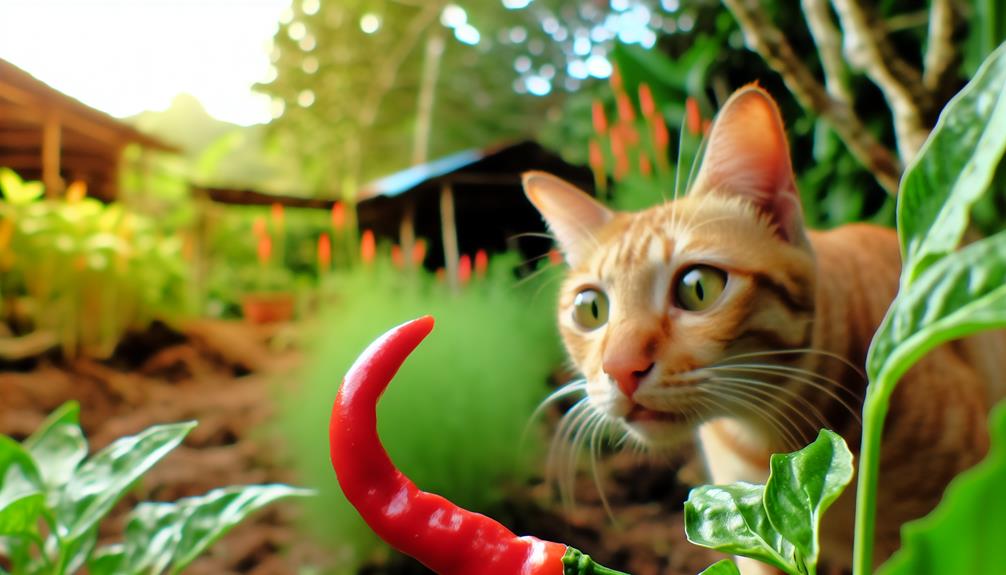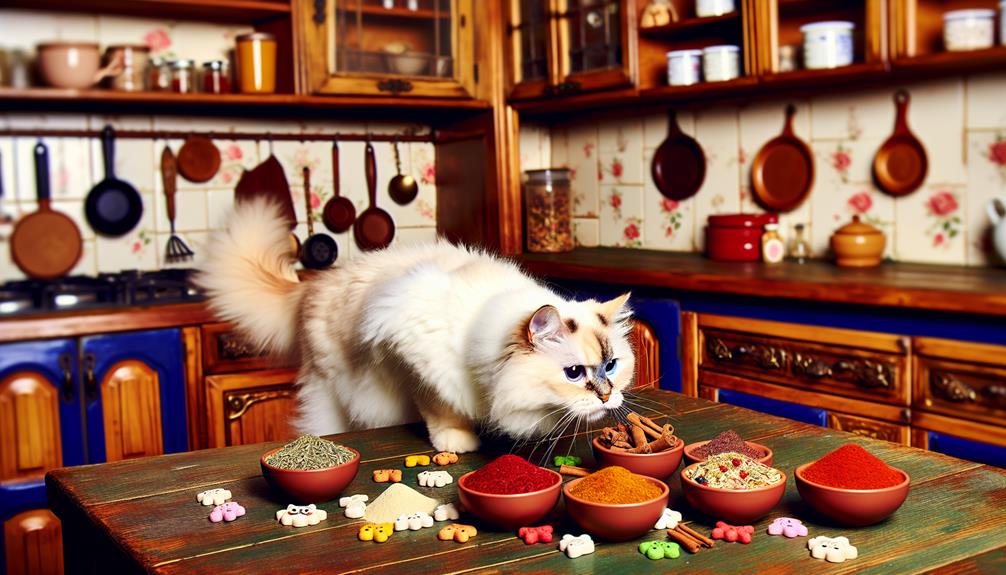Ever wondered if your feline friend can savor the heat of a spicy snack? Unlike humans, cats lack the ability to taste certain flavors, including spiciness. This intriguing difference stems from their unique evolutionary adaptations. Cats' taste buds are fine-tuned to detect amino acids rather than the capsaicin in spicy foods. Although they might show signs of discomfort, their TRPV1 receptors don't respond to capsaicin the same way ours do. But what happens when a curious cat gets a taste of something spicy? Let's explore this further to verify your pet's safety and comfort.
Feline Taste Buds
When delving into the intricacies of feline taste buds, it is essential to understand their unique structure and function. Unlike humans, cats have a comparatively limited range of taste sensations, primarily due to their evolutionary adaptation as obligate carnivores. This means their diet mainly consists of meat, and their taste buds are specifically tailored to detect certain flavors necessary for survival.
Feline flavor perception is closely linked to their taste sensitivity. Cats possess approximately 470 taste buds, whereas humans have around 9,000. Despite this limited number, they exhibit a heightened sensitivity to specific tastes, particularly amino acids, which are the building blocks of proteins. This ability helps them identify and prefer protein-rich foods, important for their dietary needs. Interestingly, cats lack taste receptors for sweetness, which is why they show little interest in sugary foods.
Scientific research indicates that the feline taste system is adept at detecting bitter compounds. This trait likely evolved to help cats avoid potentially toxic substances in their environment. Bitter taste receptors, known as TAS2Rs, are well-developed in cats, contributing to their selective eating habits and cautious approach to new foods.
From a clinical perspective, understanding a cat's taste sensitivity is essential for providing proper nutrition and managing feeding behavior. Veterinary experts often consider a cat's taste preferences when recommending diets, especially for those with health issues or finicky eating habits. By recognizing the feline flavor profile and its underlying taste sensitivity, you can make more informed choices about your cat's diet, ensuring it meets their specific nutritional requirements and promotes overall well-being.
The Science of Spiciness
Given the unique structure and function of feline taste buds, it's intriguing to explore how cats respond to different taste sensations, particularly spiciness. When you investigate the science of spiciness, you'll find that it's not a taste but rather a sensation. This sensation is primarily triggered by spicy chemicals that interact with specific sensory receptors in the mouth.
Humans experience spiciness through a compound called capsaicin, which binds to a receptor known as TRPV1. This receptor functions as a heat-activated ion channel, meaning that when capsaicin binds to it, a signal is sent to your brain, interpreting the heat as a burning sensation. However, in cats, the situation is quite different. Feline sensory receptors, including TRPV1, are less responsive to these spicy chemicals compared to their human counterparts. This reduced sensitivity is likely due to evolutionary differences in their diet and habitat.
From a scientific perspective, it's important to understand that cats are obligate carnivores. Their taste buds have evolved to prioritize the detection of necessary nutrients in meat rather than the complex flavors of plants. Consequently, the sensory receptors in cats are fine-tuned for detecting amino acids and other compounds relevant to their dietary needs, rather than spicy chemicals.
Veterinary and clinical studies further support this by showing that cats generally avoid foods containing capsaicin, not because they sense the spiciness, but due to the irritation it causes. This irritation can manifest in various ways, such as gastrointestinal discomfort, which is a strong deterrent. As a result, while your feline friend might not "taste" spiciness in the way you do, their sensory receptors still play a vital role in their overall food preferences and aversions.
Capsaicin and Cats

Capsaicin, the active component in chili peppers, plays an essential role in understanding how cats interact with spicy foods. Unlike humans, cats lack certain taste receptors, specifically those for sweet flavors, which makes their reaction to capsaicin particularly unique. Cats are obligate carnivores, and their taste buds are designed primarily to detect meat. So, when it comes to capsaicin effects, it's not about taste but rather about the sensory experience.
Clinically, it's well-documented that cats have a heightened sensitivity to capsaicin. This compound binds to TRPV1 receptors, which are responsible for sensing heat and pain. In cats, these receptors are highly sensitive, making them particularly reactive to spicy substances. The immediate response you might observe includes pawing at the mouth, drooling, or even vocalizing discomfort. These are clear indicators of feline sensitivity to capsaicin.
From a veterinary perspective, it's vital to understand that capsaicin doesn't just cause temporary discomfort. Prolonged exposure or ingestion can lead to more severe symptoms such as gastrointestinal upset, including vomiting and diarrhea. Some cats may even experience respiratory distress if they inhale capsaicin particles. As a result, it's advisable to keep spicy foods well out of your cat's reach.
Comparing Human and Cat Taste
Understanding the differences between human and cat taste involves delving into the unique anatomical and physiological aspects of both species. Taste perception varies considerably due to these differences, influencing how each species experiences food flavors, including spiciness.
For humans, taste perception is a complex interaction between taste buds, olfactory receptors, and even thermal sensations. Cats, on the other hand, have evolved with a more specialized set of taste receptors that reflect their carnivorous diet. Here are some key sensory differences:
- Taste Bud Density: Humans have approximately 9,000 taste buds, while cats have around 470. This reduced number means cats have a more limited range of taste perception.
- Sweet Taste Receptors: Humans possess taste receptors for sweetness due to their omnivorous diet, which includes carbohydrates. Cats lack these receptors entirely, making them indifferent to sugary flavors.
- Sensitivity to Bitter and Umami: Both humans and cats have receptors for bitter and umami tastes, but cats are particularly sensitive to bitter compounds. This heightened sensitivity plays a protective role, helping them avoid potentially toxic substances.
From a clinical perspective, these sensory differences have profound implications for dietary choices and nutrition. Cats rely more on their sense of smell and texture when evaluating food, rather than taste. This means that spicy foods, which humans may find appealing due to the complex interplay of flavors and heat, are unlikely to elicit the same response in cats. Their taste perception simply doesn't include the capacity to appreciate or even detect the sensation of spiciness as a human would.
Dietary Preferences of Cats

Cats, being obligate carnivores, have dietary preferences that are deeply ingrained in their physiology and evolutionary history. Their natural diet consists primarily of meat, so their bodies are optimized to digest and metabolize protein and fat efficiently. Unlike humans, cats have specific nutritional requirements that can only be met through animal-based proteins. This evolutionary background influences their cat food preferences considerably.
When it comes to flavor sensitivity, cats are quite different from humans. They have fewer taste buds, approximately 470 compared to our 9,000. This reduced number means cats aren't as sensitive to certain flavors, including sweetness. On the contrary, they are highly attuned to amino acids, which are the building blocks of protein. This sensitivity helps them identify and prefer meats that are rich in necessary nutrients.
Moreover, cats exhibit strong preferences for certain textures and moisture levels in their food. They generally favor wet food over dry kibble, likely because it more closely resembles the texture and moisture content of natural prey. Clinical experience shows that many cats are also partial to foods that have been lightly cooked or even raw, aligning with their instinctual eating patterns.
Scientific evidence supports that cats also possess a keen sense of smell, which plays a vital role in their cat food preferences. A cat's olfactory system is much more developed than its taste system, making aroma a considerable factor in food acceptance. Understanding these preferences and sensitivities can help you choose the best diet for your feline friend, ensuring they receive the nutrition they need while catering to their innate tastes and preferences.
Safe Treats for Cats
Given their unique dietary needs and sensory sensitivities, offering your cat treats that align with their natural preferences is significant. Cats are obligate carnivores, meaning their diet should be primarily composed of meat. When selecting cat treats, it's vital to choose those that contain healthy ingredients and avoid artificial additives.
Here are three types of safe treats for your cat:
- Freeze-Dried Meat Treats: These treats are made from pure animal protein and retain most of their nutritional value. Freeze-drying preserves important nutrients without the need for harmful preservatives. Look for options like chicken, turkey, or salmon.
- Commercially Prepared Cat Treats: Many high-quality brands offer cat treats specifically formulated to meet feline dietary needs. Make sure the treats list protein as the first ingredient and are free from artificial colors, flavors, and fillers.
- Homemade Treats: If you prefer a DIY approach, making treats at home allows you to control the ingredients. Simple recipes using cooked chicken or fish can be highly appealing to cats. Always verify any homemade treat is free from harmful spices and seasonings.
From a scientific perspective, it's important to provide treats in moderation. Overindulgence can lead to obesity and related health issues. Additionally, some common human foods can be toxic to cats, such as onions, garlic, and chocolate. Always consult your veterinarian before introducing new treats into your cat's diet.
Clinically, it's observed that healthy ingredients in cat treats contribute to better coat condition, energy levels, and overall health. By prioritizing quality and nutritional value, you can guarantee that your feline friend enjoys their treats without compromising their well-being.
Conclusion
In summary, while cats can't taste spiciness like humans do, it's essential to keep spicy foods away from them. Remember, "an ounce of prevention is worth a pound of cure." Cats prioritize amino acids over spicy compounds, and their TRPV1 receptors are less responsive to capsaicin. Prolonged exposure can lead to gastrointestinal issues. Stick to safe treats designed for feline dietary preferences to guarantee your cat's well-being and avoid unnecessary discomfort.
